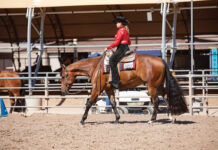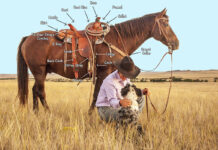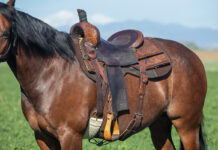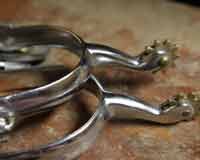
Once Winters’ horses can bend left and right, disengage their hindquarters and willingly move forward, he progresses to using a snaffle bit and eventually a curb. However, the purpose of this progression isn’t to gain more control—it’s for refinement.
“At any point in my horse’s career, I should be able to slip on a halter and lead rope and ride him around anywhere,” Winters says. Here, he explains how you can start your horse in a halter and lead rope.
Basic Groundwork
According to Winters, the basic premise of horse training is teaching a horse to yield to pressure rather than to resist it. Ground exercises such as asking your horse to willingly bend his neck side to side (lateral flexion) and encouraging him to disengage his hindquarters will help you maintain control once you’re on his back.
Winters prefers to use a hand-tied rope halter and a 12-foot lead rope when working with his horses, and he usually works in a 50-foot round pen.
Around the Bend
Lateral flexion exercises will help your horse become supple between his withers and his poll. Once he is haltered, stand next to his left shoulder, with the lead rope in your left hand. Pull the rope up toward the top of your horse’s shoulder and withers, and hold it there with some pressure. You want him to bring his head down and around toward your hip. If he moves his feet, pulls or resists, calmly hold the rope until his feet remain still and he stops pulling against you. When he relaxes and bends his head and neck toward your hip, release the pressure. Repeat the exercise on the right side.
“The teaching moment isn’t when we take a hold of the horse’s face and pull it around; it’s when we release,” Winters explains. “Reward even the slightest effort.”
Move it on Over
To work on disengaging your horse’s hindquarters, stand by his left hip with the lead rope in your left hand. You should be able to reach out and touch his left hip with your right hand. Create some energy with your body language, such as clucking or tapping him with your hand if necessary, and ask him to move his feet and step over to the right.
“I want my horse to step over in a very specific way,” Winters explains. “I want him to respond, not react. He shouldn’t just shuffle out of the way; he should take a very purposeful step, picking up his left hind foot and stepping over the right hind foot.”
In order to help your horse perform this exercise properly, you need to move when he moves. You always want to be next to his hip, so when he yields away, reposition yourself at his hip.
Remember that horses are very sensitive to body language. Some may be very leery and require a quiet approach with smooth, soft cues. Other horses may need more assertive body language, and possibly an added tap on the hindquarters with the lead rope to remind them who the leader is.
Once your horse recognizes you as the leader, use your lead rope like a longeline and ask him to walk, jog and lope around you in a circle.
Winters finds that training most young horses isn’t about getting them to stop—it’s about getting them to go forward. The objective of this round pen exercise is to encourage your horse to go. You want him to be comfortable moving his feet so transitioning between the walk, jog and lope are familiar concepts when you get in the saddle.
Mounting Up
If a horse can willingly bend his nose around to the left and right, and move his hindquarters away from pressure, then he has the elementary stages of control and is ready for under-saddle work, says Winters. Mounting a green horse for the first time is a multi-step process, so remember to be relaxed and patient. Your first few rides should be positive experiences for your horse.
To prepare for mounting, Winters will place his left foot in the stirrup, step halfway up in the saddle and rub the horse. The next time, he will step halfway up and ask his horse to move his hindquarters over by tipping the horse’s nose laterally while clucking and encouraging him to move his feet. Winters will perform this exercise on both sides before fully mounting. If you’re not experienced with green horses, make sure you have the help of a trainer or an experienced ground person.
When you’re ready to fully mount, your lead rope will function as your reins, so it should be connected to the base of the halter. The other end of the lead rope should be tied as close to the base of the halter as possible so the horse’s connection to your hands is similar on each side.
| Meet the TrainerFor nearly three decades, Richard Winters has dedicated himself to honing his horsemanship skills and passing this knowledge on to others. His vast experience includes starting hundreds of horses that have gone on to almost every equine discipline imaginable. Winters’ credentials include World Championship titles in the National Reined Cow Horse Association along with being an A-rated judge. In 2007, Winters was named champion of the West Coast Equine Experience $10,000 Colt Starting Challenge. He was also presented with the 2007 Monty Roberts Equitarian Award for outstanding achievements in horse-human relationships. Winters was also honored to be named champion in the 2009 Road to the Horse Colt Starting Challenge in Nashville, Tenn. In July of 2009, Winters won the Super Cow Horse competition in Santa Ynez, Calif. Much of Winters’ work has been accomplished through the numerous clinics he conducts around the country. He also enjoys being a guest presenter at various horse expos. For more information about Richard Winters Horsemanship, please go to www.wintersranch.com |
Another reason Winters starts a horse in a halter and lead rope is to protect the horse’s mouth. If things fall apart for any reason—the horse bucks or spooks and throws the rider off balance—the rider won’t jerk on the horse’s mouth.
Winters prefers to ride his horses in the same 50-foot round pen he uses when working on the ground.
“One of the first things I do when I mount up is bend my horse a little bit,” Winters says. “I want to do something productive, so I’ll get on his back and move him around. I’ll use a little right leg and raise my right rein and ask him to move his hindquarters to the left. I want him to realize that he can move his feet without falling apart. This is the same yielding exercise I asked for when I was on the ground and when I mounted halfway up.”
Your horse should start to loosen up as you continue to ask him to move his hindquarters left and right. “As my horse moves his hind feet, there’s a natural segue for him to take one or two steps forward,” says Winters. “When he does that, I’ll rub him to show him that he did a good job.”
Winters says if he’s on a horse that gets stuck when he asks for forward movement, he’ll ask the horse to move his hindquarters again. The goal is for the horse’s feet to stay busy. “I don’t care where they go, I just want them to move,” Winters adds.
Working in the Saddle
Winters explains that while your horse may understand lateral flexion on the ground, it will be a learning transition for him to realize that even though you’re on his back, you still want the same thing: His feet should be still, and he shouldn’t pull on you.
To ask your horse to bring his nose around to the left, softly draw your left hand up to the pocket of your jeans and wait for his head to come around to your knee. He may shuffle a few steps or back up. Keep your body neutral during this exercise. Be patient and wait for him to realize what you want him to do. Repeat this exercise to the right.
Remember that the first few rides are learning experiences for your horse. “Horsemanship is making the right thing easy and the wrong thing difficult,” Winters says. “It’s in a horse’s nature to seek a comfort zone. Horses want someone to stand up and say, ‘Go this way and it will work out well for you.’”
According to Winters, the more time you spend working on lateral flexion, the better. A horse that’s supple is much less likely to pull against his rider during transitions and turns. You can also combine lateral flexion with asking your horse to move his hindquarters.
“Say I’ve lifted my right rein and my horse’s nose is at my right boot,” Winters explains. “I might look back at his right hip, squeeze with my right leg and ask him to yield his hindquarters 180 degrees to the left. Then my body will go neutral and I’ll ask him to stand still and finish the movement with lateral flexion.”
Starting your horse in a halter and lead rope is all about progression. Once your horse is moving around you in a round pen in a halter and lead rope, asking him to do so with you on his back is a natural step. You can advance to using a snaffle and eventually a curb bit when you and your horse are ready for more advanced work.
Further Reading
Body Language
A Good Ground Game
Allison Griest, a contributing editor who lives in Texas, is an aspiring reiner.
This article originally appeared in the February 2010 issue of Horse Illustrated. Click here to subscribe.






I started my mare with a rope halter & still enjoy riding her that way now she’s 6. We’re in a snaffle now, but love going bitless a good deal of the time. My 19h Friesian is ridden the same way.It surprises some that we get along so well. I wouldn’t have it any other way. Article is right on!
Great article! I think to truly communicate well with your horse, you should be able to ride bitless. I really like that there are clinicians out there that use just a bosal, or a hackamore. Bits have their place, but for pleasure riding around the property or on trails, going bitless is a nice break for the horse, and an opportunity for the rider to hone in on their communication skills.